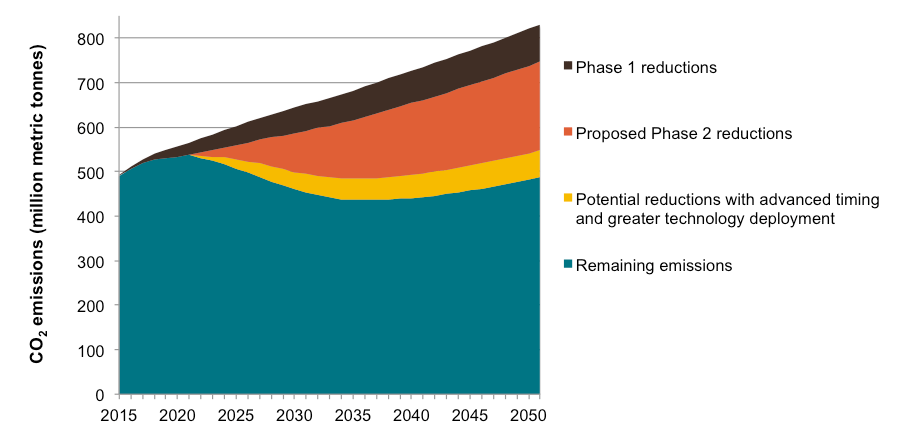Parsing Phase 2: Tractor-trailers in the proposed regulation
Blog
What is at stake in the U.S. truck efficiency rule
In the California Air Resources Board hearing on July 23, 2015, the Board received testimony from stakeholders on how the federal U.S. rulemaking on heavy-duty vehicle efficiency might change. One of the resounding calls for action was to bring the proposed EPA and NHTSA standards forward by two to three years. Another was to increase the standards’ stringency in several areas.
As I reflected on the various stakeholders’ remarks, I couldn’t help but wonder, how much could be in play? The proposed rule is expected to reduce GHG emissions by 150 million metric tons per year by 2040, and cut oil use in the United States by over a million barrels per day. How much further might it go, though? This is a key question for many environmental and industry stakeholders, as they prepare to submit formal public comments on the proposal in early September.
To satisfy my curiosity, I recruited some colleagues and we analyzed the impact of advancing the timing of the implementation of the Phase 2 standards. This is what the agencies referred to as shifting from their preferred Alternative 3 to Alternative 4, which generally reaches the same stringency for all the vehicle categories three years earlier. This would bring the proposed 2027 standards into force by 2024. We also analyzed the extent to which standards for the particular vehicle subcategories (i.e., engines, vehicle types, trailers) could be strengthened to require more technology to enter the fleet. We call this scenario, which includes the impacts of both pulling the standards forward and increasing the stringency, “Alternative 4 plus.”
To analyze the fuel consumption and CO2 impacts of both scenarios (i.e., Alternative 3 and Alternative 4 plus), we utilized the population and VMT estimates from the EPA MOVES model, along with all the vehicle stringency assumptions of the USEPA/NHTSA proposed rule, with additional assumptions from the latest ICCT analyses (on trailers, on tractor-trailers, on SuperTruck, on pickups and vans), WVU, ACEEE, and SwRI. Alternative 3 is modeled as closely as possible to the proposed Phase 2 regulation, using the percent efficiency gains calculated from the vehicle standards for tractor trucks, trailers, vocational vehicles, and heavy-duty pickups.
The regulatory timing assumptions for Alternative 4 plus are modeled after Alternative 4 in the proposal, in which the standards for vehicles and engines are brought forward three years and the full implementation of the proposed Phase 2 regulation is achieved in the 2024 timeframe. However, in terms of the technologies and efficiency improvements, the Alternative 4 plus scenario is more stringent than the agencies’ Alternative 4. For tractors, the proposed Phase 2 stringency ranges from 11% to 24% compared to a model year (MY) 2017 baseline. In our Alternative 4 plus scenario, this range is bumped up to 15%–28%, based on the assumption of accelerated penetration of a more stringent engine standard (from 4% up to 8%). For trailers, our more aggressive scenario brings the stringency from the 3%–9% range up to 4%–11% by assuming faster deployment of highly aerodynamic box trailers. In the vocational vehicle segment, we assume that greater penetration of powertrain integration and hybridization leads to an increase in stringency from roughly 13% to approximately 20%. Finally, for heavy-duty pickups and vans, while the agencies chose 2.5% per year improvements in efficiency for their Alternative 3, we assumed 4.0% per year improvements through 2024, resulting in an overall stringency increase from 12% to 18%.
The figure below illustrates the reductions in CO2 emissions from 2015 through 2050 for (1) the Phase 1 regulation; (2) the Phase 2 proposal; and (3) Alternative 4 plus, which assumes advanced timing and stringency. As we just testified at the August 6 Chicago hearing on the standards, the proposed rule is predicated on proven, well-understood, available, and highly cost-effective technologies. Based on our reading of the agencies’ technical analysis and the studies mentioned above, the technical readiness allows for the higher technology penetrations, advanced by three years, shown in the figure.

Reductions in CO2 emissions from the Phase 1 regulation, the proposed Phase 2 reductions, and an alternative advanced scenario.
So what do we see? The benefits of the more advanced scenario, represented by the yellow wedge in the figure, are substantial. This alternative yields additional annual benefits of over 40 million metric tons (MMT) CO2 in 2030, compared to the proposed Phase 2 regulation. The increased efficiency from pushing more technology into the fleet could deliver annual CO2 and fuel use reductions that are over 30% greater in 2040 than the proposed Phase 2 standards. In 2040, these changes in advanced timing and technology penetration would result in an additional 53 million tons CO2 per year, and 340,000 barrels per day in oil equivalent savings over the agencies’ proposal.
The energy and carbon reduction benefits are quite substantial. For context, the benefits of the more advanced scenario, compared to the agencies’ proposed standards, would amount to about as much oil as the United States imported in 2014 from Russia, our fifth-largest foreign oil source. These potential extra benefits above the proposed standards would also amount to two-fifths of the Keystone XL pipeline capacity of 800,000 barrels of oil per day. The annual carbon savings of strengthening the agencies’ proposal would be equivalent to taking 13 million of today’s automobiles off the road (i.e., 30 mpg cars at 12,000 miles per year).
So, what is at stake? Quite a lot! Make no mistake, this is a progressive rule of a very complicated sector (one where many other governments are doing little…), and the climate and energy security benefits are going to be substantial. But let’s also be clear: the potential additional gains that are still on the table are also substantial.
